Abstract
The ground surface soil heat flux (G0) quantifies the energy transfer between the atmosphere and the ground through the land surface. However; it is difficult to obtain the spatial distribution of G0 in permafrost regions because of the limitation of in situ observation and complication of ground surface conditions. This study aims at developing an improved G0 parameterization scheme applicable to permafrost regions of the Qinghai-Tibet Plateau under clear-sky conditions. We validated several existing remote sensing-based models to estimate G0 by analyzing in situ measurement data. Based on the validation of previous models on G0; we added the solar time angle to the G0 parameterization scheme; which considered the phase difference problem. The maximum values of RMSE and MAE between “measured G0” and simulated G0 using the improved parameterization scheme and in situ data were calculated to be 6.102 W/m2 and 5.382 W/m2; respectively. When the error of the remotely sensed land surface temperature is less than 1 K and the surface albedo measured is less than 0.02; the accuracy of estimates based on remote sensing data for G0 will be less than 5%. MODIS data (surface reflectance; land surface temperature; and emissivity) were used to calculate G0 in a 10 x 10 km region around Tanggula site; which is located in the continuous permafrost region with long-term records of meteorological and permafrost parameters. The results obtained by the improved scheme and MODIS data were consistent with the observation. This study enhances our understanding of the impacts of climate change on the ground thermal regime of permafrost and the land surface processes between atmosphere and ground surface in cold regions.
1. Introduction
The total area of the Qinghai-Tibet Plateau (QTP) is approximately 2.57 million km2 and it has an average elevation of over 4000 m [1]. This explains why it is called ‘the roof of the world’ or the Earth’s third pole. It is estimated that 54.3% of the QTP is located in permafrost regions, which is vulnerable to thawing due to ongoing climate change [2]. The permafrost changes under the scenarios of climatic warming would have significant impacts on the land surface processes, hydrological cycles, and ecosystem from regional to global scale [3]. It is of great significance to improve the ground surface soil heat flux (G0) parameterization scheme to understand the impacts of climate change on the ground thermal regime in cold regions.
Ground surface soil heat flux (G0) is an important parameter characterizing the energy balance between the ground surface and the atmosphere. The soil’s state and thermal performance have significant impact on G0 [4]. Freeze-thaw cycles are particularly significant in determining the energy exchange profile between ground surface and atmosphere in the region and through the year [5,6,7,8]. Phase change in the active layer during thawing periods consumes a large amount of heat [9]. Soil moisture content also increases during thawing periods, which can regulate the energy flux and temperature gradient between the permafrost soils and the atmosphere to some extent [10]. However, during freezing periods of ground surface, the temperature gradient between the ground and air across the freezing zone increases relatively due to the phase change, which enhances the heat release intensity of the system to the atmosphere. G0 manifests the energy exchange between the active layer and the atmosphere and it affects the energy budget of the active layer and permafrost, so it is important to understand the freeze-thaw process that takes place within the ground surface in the QTP region, as well as degradation or development of permafrost through time [11]. This type of analysis requires the effective parameterization of ground surface soil heat flux [12].
The single-point method of obtaining a value for ground surface soil heat flux includes observation and calculation [13]. The observation methods mainly involve PlateCal (Combination of Heat Flux Plate Measurements and Calorimetry) [13,14,15,16,17] and TCAV (Averaging Soil Thermocouple Probe) [14,18]. Studies by Yu et al. [19] and Xu et al. [14], however, demonstrated that it is still challenging to accurately measure the surface soil heat flux using the heat plates. Surface soil heat flux can also be calculated using the soil temperature and soil moisture measurements [14]. Calculation methods include the Harmonic analysis Method (HM) [20], the Lambda Method (Incorporation of Thermal Conduction and Convection) [21], and the TDEC (the correction of thermal diffusion equation) [22].
Soil temperature and moisture data cannot be obtained directly through optical remote sensing imaging [23,24,25,26], but the measured net radiation flux (Rn) can be divided into three parts: latent heat flux, sensible heat flux, and surface soil heat flux (G0), so if the ratio of G0 to Rn is known, then it can be used to estimate G0 from remote sensing data. It is important to use an accurate ratio to accurately estimate G0. Previous studies suggested that the G0/Rn ratio at the surface of bare soil is approximately 0.3 [27,28,29], and may reach to 0.5 for dry soil surfaces [29]. For vegetated surfaces, studies have shown that G0/Rn is related to the local vegetation indices, which can be obtained from remote sensing data products. For vegetation surfaces under full coverage, G0/Rn ranges between 0.05 and 0.1 [30]. Reginato et al. calculated G0/Rn according to crop height using an empirical formula [31]. Choudhury et al. obtained G0/Rn as an exponential function of the leaf area index (LAI), yielding a correlation coefficient of 0.90 [18]. Jaskson et al. calculated G0/Rn using an exponential function based on the normalized difference vegetation index (NDVI) [32]. Su proposed that G0/Rn can be calculated for different ground surfaces, including for regions with full vegetation coverage, for completely bare land, and for those regions with varied vegetation coverage [33]. The NDVI is sensitive to solar position and to the variability in soil reflectance factors [34,35,36], so there are some uncertainties in the estimates of NDVI itself. Menenti et al. [37] and Bastiaanssen [23] established an improved scheme for obtaining the G0/Rn ratio, related to parameters such as land surface temperature and surface albedo. Ma et al. [38,39] proposed the use of MSAVI (Modified Soil Adjusted Vegetation) in arid and semi-arid and high altitudes regions, instead of NDVI.
There are also case studies that focus on the issue of phase differences between Rn and G0 [40,41]. The phase difference is related to the soil type, soil moisture content, and vegetation condition [40]. Due to the existence of permafrost under the active layer (i.e., the effect of a water-proof layer of permafrost), the soil moisture content in the active layer in summer is higher than that of shallow soil on seasonally frozen ground. As a result, vegetation coverage can be higher over permafrost than over seasonally frozen ground. The phase differences over permafrost are therefore different to those over seasonally frozen ground. This difference can be significant for the permafrost regions of the Tibetan Plateau and is, therefore, explored in this study. When combined with the widely used MODIS data, accurate estimates of the ratios to be used can provide estimates of G0 close to “true value” in areas with high spatial resolution (1 km).
The performance of several remote sensing models used to estimate G0 were compared in this study, and the model with the least error was selected as the G0 scheme for the QTP. Furthermore, the solar time angle was added into the G0 parameterization scheme to solve the phase difference problem. The improved G0 parameterization scheme was then validated by testing it against data directly measured across a 10 × 10 km area of permafrost at the Tanggula (TGL) station. Since the MODIS data integrity is susceptible to the cloud, and considering the conditional limitation of the solar time angle (Rn > 0), the improved G0 parameterization scheme is only applicable to the daytime of the clear-sky days.
2. Study Region and Data Collection
Observation data were collected from seven automatic weather stations: (Xidatan (XDT), Tanggula (TGL), Ayake (AYK), Zuonaihu (ZNH), and MS3478 (NPAM) in the permafrost region and Amdo, MS3637 (SPAM) in the seasonally frozen ground regions) on the Qinghai-Tibet Plateau (QTP) (Table 1). A 10 × 10 km permafrost region (33°0.8′N~33°6.6′N, 91°51′E~91°56.7′E) at Tanggula (TGL) was selected for the validation case study (Figure 1). The background maps on the left and right of Figure 1 are the spatial distribution map of frozen ground on Qinghai-Xizang Plateau [42] and ASTER Global Digital Elevation Model respectively.

Table 1.
Observation instruments and observation parameters.
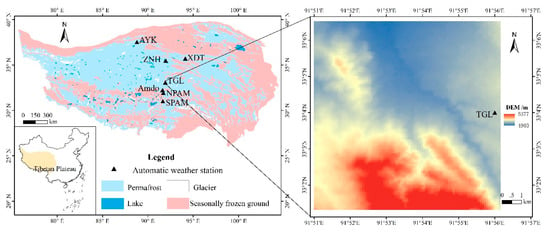
Figure 1.
Map of the distribution of observation sites.
AYK is located at the boundary region between the permafrost and the seasonally frozen ground on the QTP, which is covered by sparse desert grasslands. ZNH is located in the continuous permafrost region and is covered by desert grasslands and sparse vegetation. TGL is located in the continuous permafrost region and is covered by alpine steppe. XDT is located in the sporadic permafrost region near the northern lower limit of the permafrost on the QTP. NPAM is located in the permafrost region [42], where the surface consists of sandy clay containing fine stones. This area is covered by alpine meadows about 15 cm high. Both Amdo and SPAM are located in the seasonally frozen ground regions, and both sites are covered with alpine meadows [43].
The in situ measurement data and remotely sensed data were compared in this study. The in situ observation data included surface radiation values, land surface temperatures, soil heat flux measured at the AWSs, soil temperature profiles, and soil moisture profile (Table 1). The GAME-Tibet (Asian Monsoon Experiment on the Tibetan Plateau) was carried out from May to September in 1998, so measured data for the three sites (Amdo, NPAM and SPAM) were obtained from the GAME-Tibet project, collected during this period. The temporal resolution of the data collected from the SPAM site is every 1 h, while the temporal resolution of the data obtained from other six stations is 30 min.
Remote sensing data included the MODIS satellite data products and NOAA-14/AVHRR satellite data. The attributes of the remotely sensed datasets are shown in Table 2. NOAA-14/AVHRR data provides spectral reflectance at red and short-wave infrared bands. These are used to estimate the MSAVI (Modified Soil-Adjusted Vegetation Index). MOD/MYD09 data products are used to estimate the vegetation indices (NDVI, MSAVI and vegetation coverage fc) and the albedo. MOD/MYD11_L2 data products are used to provide the land surface temperature and estimates of the land surface emissivity. The MOD/MYD03 geolocation data product provides the latitude and longitude information allowing geocalibration of the MOD/MYD11_L2 and MOD/MYD09 data products. Algorithms for the retrieval of land surface parameters from the remote sensing datasets are described in detail in Section 3.2 and Section 5.2.

Table 2.
Specifications of remote sensing datasets.
3. Data Processing Methods
G0 cannot be directly observed at a site and Section 3.1 describes the acquisition of G0 at sites in detail. The main G0 parameterization schemes were tested by comparing the synthetic results with the automatic weather station (AWS) data measured in situ. By comparing the AWS data with the remote sensing products produced vegetation indexes (NDVI, MSAVI and fc), the most effective G0 parameterization scheme was identified (Section 3.2). The solar hour angle was also added in to the selected G0 parameterization scheme to improve the performance of the model (Section 3.3). Figure 2 demonstrates all the processes.
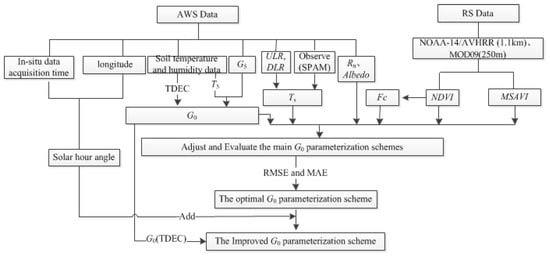
Figure 2.
Flow chart of the of optimizing process for G0 parameterization scheme.
3.1. Calculation of G0 at AWS Sites
Two methods were used to calculate the surface soil heat flux at the sites (Figure 2). The first method was to calculate G0 from the soil heat flux measured at a depth of 5 cm using a heat flux plate. The soil temperature at the 5-cm depth was used to carry out the calculation as follows [15]:
where G5 (W·m−2) is the measured soil heat flux at a depth of 5 cm; Cs is the volumetric soil heat capacity (a value of 1.18 × 106 J·m−3·K−1 was used in this study [44]); T is the soil temperature at a depth of 5 cm; and t stands for the time of each measurement. We can call this the Plates method. The other method used the Thermal Diffusion Equation and Correction (TDEC) algorithm, as demonstrated by Yang and Wang [22].
The G0 calculated by the Plates method somewhat underestimates the actual value (Figure 3a). Plates (Equation (1)) assumes that the volumetric soil heat capacity cs is the same between the surface and underground depths of 5 cm (1.18 × 106 J·m−3·K−1) and that the soil temperatures at different depths have the same rates of change at any time. The rate of change of soil temperature with time over a set period, however, increases with the decrease of soil depth (Figure 3b). The TDEC method has been shown to be insensitive to the soil thermal conductivity coefficient, and its reliability has been verified by the twin experiment [22]. Some studies on the plateau have shown that the TDEC method has better accuracy [12,13,45]. In this study, the values of G0 at the Amdo, NPAM, SPAM, and TGL sites were acquired using the TDEC method. G0 at the other sites was calculated by the Plates method because of the limited availability of measured data (Table 1). The TGL site data could be used for both the Plates and the TDEC. Data from the four sites (XDT, AYK, ZNH, and TGL in 2014), which could be used with the Plates method, was used to calibrate the four existing models, to evaluate their applicability on the plateau, and to select the best applicable scheme (Section 3.2 and Section 4.1). Data from four sites (Amdo, NPAM, SPAM and TGL) satisfying TDEC were then used to obtain an improved scheme based on the applicable scheme (Section 3.3 and Section 4.2) and to verify the reliability of the improved scheme at those sites (Section 5.1).

Figure 3.
Linear relationship between G0_TDEC and G0_Plates (a) and the temporal variation characteristics of soil temperature at the TGL site, at depths of 5 cm, 10 cm, and 20 cm (b).
3.2. Testing the G0 Parameterization Schemes
There are several empirical remote sensing models for estimating Γ(G0/Rn), such as SEBAL [23], Ma [38], Moran [46], and SEBS [33] (Table 3).

Table 3.
Common remote sensing-based models for estimating Γ (G0/Rn).
The stations (TGL, XDT, ZNH, AYK, NPAM and Amdo) do not provide measured land surface temperature data (Ts), but Ts can be obtained using long wave radiation data as follows [47]:
where Ts is the land surface temperature (°C), Ru and Rd are the incoming and outgoing long wave radiation powers, respectively (W/m2). σ is the Stefan-Boltzmann constant (5.67 × 10−8 W·m−2·K−4), ε is the land surface emissivity, which is approximately 0.95 on the plateau [44].
The net radiation Rn can be obtained from short-wave and long-wave radiation and the land surface albedo α is the ratio of downward to upward shortwave radiation:
Both the NDVI [48] and the MSAVI [49] use combined values of red (RED) and near red (NIR) bands of remote sensing data:
RED and NIR are land surface reflectance values of band 1 and band 2 of MYD09 or AVHRR-1 and AVHRR-2 of NOAA-14/AVHRR, respectively. Vegetation coverage fc can be obtained via the NDVI [50]:
where NDVImax and NDVImin are the NDVI values for bare soil and full vegetation coverage, respectively.
The coefficients in these original models should be validated with in situ measurement data for the different cases, so that there will be eight models (four prototypes and four calibrated). The accuracies of the values produced by the models were evaluated using the mean absolute error (MAE) and the root-mean-square error (RMSE).
In the eight specific forms of the G0 parameterization scheme, the best one will be selected by MAE and RMSE as the basic scheme to be improved, and it can be expressed as:
where, Γbest (G0/Rn) is the best of the eight models.
3.3. Improvement of the G0 Parameterization Scheme
Observations (Figure 4) showed that both Rn and G0 undergo obvious daily fluctuations, and the change of surface soil heat flux G0 lags behind the change of net radiation Rn [51], which means that there is a phase difference between Rn and G0. Previous studies used the solar hour angle to solve the issue of phase difference between Rn and G0 during the daytime [40]:
where Rn is the net radiation, “Rn > 0” represents daytime; a is the amplitude parameter, which must be determined based on measured data; b is the period of 1 day, and b = 86,400 s (i.e., 24 h); c is the phase shift. Observed values for Rn and G0 must be used to determine the value of c. Colaizzi et al. used 10,800 s as the value of c in their paper [41]; t is the solar time angle(s) [52].
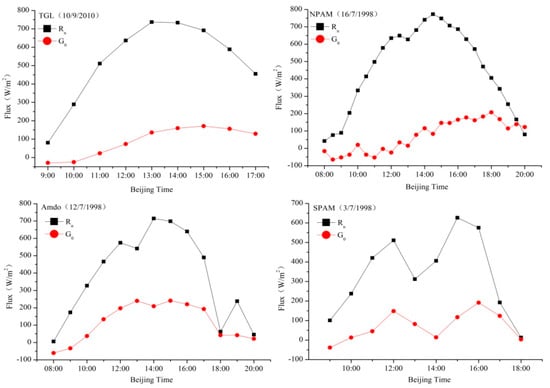
Figure 4.
Daily fluctuations of net radiation Rn and ground surface soil heat flux G0 at TGL, NPAM, Amdo and SPAM sites on a sunny day.
We then used the solar time angle to solve the problem of the phase shift between Rn and G0 on the QTP under clear-sky conditions, and can then derive the preliminary form of the improved scheme based on Equations (8) and (9):
There are only two unknowns; the phase shift c and the amplitude parameter a in Equation (10). Both c and a can be determined using the data for the four TDEC sites. The coefficients of determination (R2) of the linear relationship between f(Γbest, Rn, c, t) and G0 in the case of different phase shifts are obtained from the in situ measured data. The overlapping value of the phase shifts that their corresponding R2 are greater than R2 without considering the phase shift at each site is taken as the optimal phase offset c between G0 and f(Γbest, Rn, c, t) in permafrost regions of the QTP. The same amount of measured data from each site located at permafrost regions of the QTP were selected to form an observed dataset. The value of the amplitude parameter a can then be obtained by introducing the measured dataset and the known c value into Equation (10).
4. Results
4.1. The Best Form Γbest of Γ(G0/Rn)s on the QTP
SEBALadj, Maadj, Moranadj, and SEBSadj are the modified versions of the SEBAL, Ma, Moran, and SEBS models respectively (Table 4) and the modified versions of the four schemes are shown in Appendix A. The prototypes of these models are shown in Table 3. From the mathematical forms of the SEBALadj and Maadj parameterization schemes (Table 4), it can be seen that the simulated G0 of the two schemes will always be less than 0 in the daytime when the vegetation index (NDVI or MSAVI) is high and land surface temperature Ts is higher than 0, which is inconsistent with the actual situation., which is inconsistent with the actual situation. In the case, it is unfortunately not possible to use the two adjusted schemes.

Table 4.
Adjusted Remote Sensing Model of Estimating Γ(G0/Rn).
According to the observation data, the corresponding “measured” G0 and Ts have negative values when net radiation Rn is greater than 0 (daytime). However, from the mathematical forms of these schemes (Table 3 and Table 4), we can know that the schemes Moran, Moranadj, SEBS and SEBSadj cannot simulate the negative G0 and the schemes SEBAL and Ma can simulate the negative G0 (Whether the simulated G0 by the schemes SEBAL and Ma is negative or not depends entirely on the corresponding “measured” Ts). It can be seen that both schemes SEBAL and Ma performed better than the schemes Moran and SEBS. In addition, some studies proposed using MSAVI (Modified Soil Adjusted Vegetation) instead of NDVI in arid and semi-arid and high altitudes regions [38,39]. Therefore, The Ma scheme is suitable for the QTP.
Both the MAE and RMSE (Table 5) obtained using the validation data in Table A1 of Appendix B clearly showed that the modified Moranadj and SEBSadj parameterization schemes performed better than the original Moran and SEBS schemes; however, the Moran and SEBS schemes were significantly worse than the Ma and SEBAL schemes for producing MAE and RMSE values, and the estimated G0 values using the Ma scheme were slightly better than those using SEBAL, overall. In addition, Ma et al. [38] determined the original form of the Ma scheme by using data from 6 stations on the northern QTP including Amdo, NPAM and SPAM. The Ma scheme is the most suitable for the QTP and was verified by 7 sites (TGL, XDT, ZNH, AYK, Amdo, NPAM, and SPAM).

Table 5.
MAE and RMSE for G0 parameterization schemes at 4 stations (W/m2).
According to the mathematical form and RMSE/MAE of each scheme, we choose the scheme Ma as the best form Γbest of Γ(G0/Rn)s on the QTP. So the improved scheme can be called the Maimpr scheme and can be expressed as:
4.2. The Specific Form of the Improved G0 Parameterization Scheme Maimpr
The specific values of the phase shifts c and the coefficient a in the Maimpr scheme (Equation (11)) can be obtained from observation data from each site.
4.2.1. Determination of the Optimal Phase Shifts c on the QTP
The coefficients of determination (R2) of the linear relationship between f(Γbest, Rn, c, t) and G0 in the case of different phase shifts are obtained from the in situ measured data. The phase shift corresponding to maximum R2 is taken as the optimal phase offset c between G0 and f(Γbest, Rn, c, t) at a site. Taking TGL as an example, the relationship between f(ΓMa, Rn, c, t) and G0 in the case of different phase shifts c (Figure 5) is obtained from the observation data from TGL (Table A2 in Appendix B), and the best phase shift c at TGL can be identified. In the same way, the optimal phase shifts (Table 6) are obtained for the three sites of NPAM, Amdo, and SPAM. The best phase shifts for TGL, NPAM, Amdo, and SPAM are -3h, -5h, and no cos (“no cos” means that the scheme does not include a solar time angle that is to say that it is by default the Ma scheme). The best phase shift is in fact “no cos”, which does not mean that there is no phase shift between G0 and Rn, but only that the phase shift between G0 and Rn in the seasonally frozen soil areas is small (Figure 6). Considering the surface temperature, surface albedo, and MSAVI, the phase shift effect is removed. There is a certain difference in the optimal phase shift c at each site, which may be related to the type of frozen ground at each location. Different types of frozen ground may cause different time differences in surface energy conversion. After considering the solar time angle, the coefficient of determination R2 at TGL and NPAM in the permafrost region does increase, while R2 reduces at SPAM and Amdo, which are located in the seasonally frozen ground region. The Ma scheme still produces the best estimates for the seasonally frozen ground region. The Ma scheme is, therefore, used in the seasonally frozen region, while the model needs further improvement in the permafrost region.
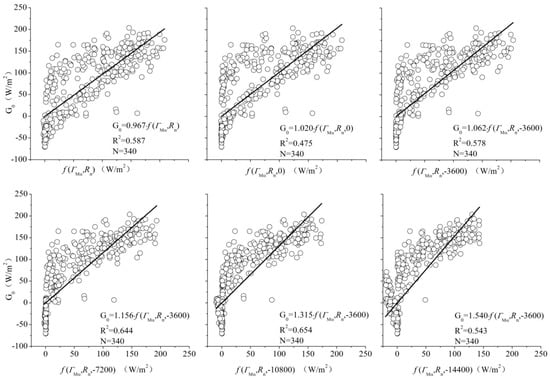
Figure 5.
The relationship between G0 and f (ΓMa, Rn, c, t) under the different phase shifts in TGL.

Table 6.
The coefficient of determination R2 of f (ΓMa, Rn, c, t) and G0 at the four stations with different phase shifts c.
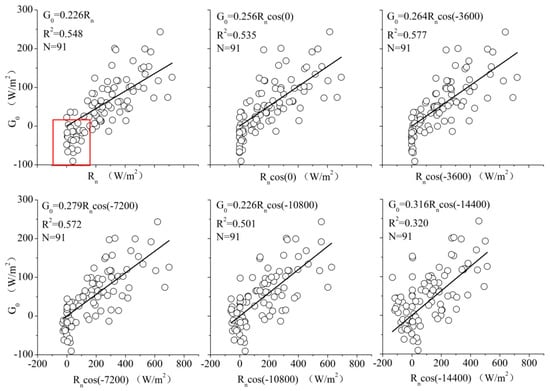
Figure 6.
The relationship between G0 and Rn(t) under the different phase shifts at SPAM.
The sign of the phase shift c represents the chronological direction of translation of the net radiation Rn. Since the change of surface soil heat flux G0 lags behind the change of net radiation Rn, Rn needs to shift to the right, and the cosine of the rightward translation should be the negative value of the amount of translation, so the sign of the phase shift c should be negative.
In Table 6, the best phase shift at TGL is also −3 h, while the best phase shift c at NPAM is −5 h. When the phase shift c of TGL is greater than −3 h, the R2 will be less than 0.587, which is the coefficient of determination without cosine function. When the phase shifts of TGL and NPAM are −3 h, their coefficients of determination are higher than the coefficients of determination without cosine function. In this case, it was decided to use −3 h as the best phase shift for the permafrost, i.e., the permafrost phase shift c is equal to −10,800 s (−3 h).
Regardless of whether or not phase offset or how much phase offset is considered, the simulation results are not good in the negative part of G0 (Figure 5). It should be related to the actual relationship between the “measured” G0 and measured Rn at sites. Most remote sensing-based models to estimate G0 are established on the basis of the relationship between G0 and net radiation Rn. These models consider other land surface parameters, such as land surface temperature, albedo and vegetation index, in order to better simulate G0/Rn values. The purpose of this manuscript is to establish a G0 parameterization scheme in sunny days on the QTP. The standard for daytime selection is that net radiation Rn is greater than 0. It can be seen that the relationship between the “measured” negative G0 and the simulated results f (ΓMa, Rn, c, t) (It can be approximated as G0 analog value, Figure 5) is very similar to that between the “measured” negative G0 and observed Rn (the red box area in Figure 6). Therefore, it is caused by the relationship between the “measured” negative G0 and measured Rn that the simulation results of remote sensing-based models in the negative part of G0 are not satisfactory during daytime of the clear-sky days. According to in situ measurement data of sites, the majority of the “observed” G0 are larger than 0. So the poor effect of negative simulation will affect the application of these models in daytime.
4.2.2. Lookup for the Coefficient a
When the phase shift was equal to -10,800s in Equation (11), only the coefficient a is unknown and its value can be calculated based on the fitted data for clear-sky conditions (Table A3 in Appendix B). The coefficient a at TGL (a = 1.3232) was close to the NPAM coefficient a (a = 1.2173). It is reasonable to apply the TGL and NPAM values across all of the sites, and 1.2686 can be used as the average permafrost coefficient a.
From Figure 7, the instantaneous value of the surface albedo α in the time range from 10:00 to 16:00 is approximately equal to the daily average value of the surface albedo α on the same day. The Maimpr scheme can then be simplified as Equation (12):
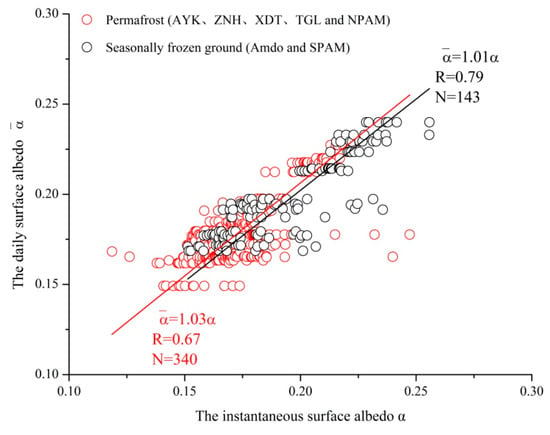
Figure 7.
Relationship between the land surface albedo instantaneous value α and the daily mean value α in permafrost and seasonally frozen ground.
5. Discussion
5.1. The Uncertainty Analysis of the Improved G0 Parameterization Scheme Maimpr
The uncertainty of the scheme was analyzed using data from the TGL and NPAM sites and using the R software (R x64 3.5.0, https://www.r-project.org/), as shown in Figure 8 and Table 8.
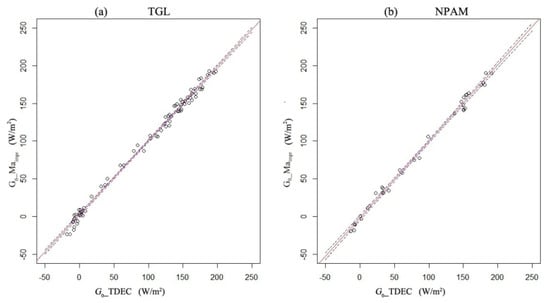
Figure 8.
The linear relationship between the land surface soil heat flux G0 calculated by the TDEC method (G0_TDEC) and the parameterization scheme Maimpr (G0_Maimpr) using measured data from the TGL and NPAM sites (the red line represents a straight line with a slope of 1 and an intercept of 0). The blue line represents the 95% confidence interval line. Land surface temperature Ts is obtained by Equation (2) using observed long wave radiation.
At the TGL and NPAM sites (Figure 8 and Table 7), the slope and worst intercept absolute value from the linear relationship between G0(TDEC) and the simulated values of G0 using the Maimpr scheme are around 1 and around 5 respectively, within the 95% confidence interval. The p values are all less than 0.01. The RMSE values of G0 estimated by the Maimpr scheme at the TGL and NPAM sites are 6.102 W/m2 and 5.756 W/m2, respectively, the MAE values are 5.382 W/m2 and 4.878 W/m2, respectively, and the values of RMSE and MAE are less than 7 W/m2 at both sites. In summary, the simulated results using the G0 parameterization Maimpr scheme are reliable when the input parameters are measured data.

Table 7.
The uncertainties in the simulated G0 by the Maimpr scheme using in situ data from TGL and NPAM stations.
As some parameters for the Maimpr scheme are derived from remote sensing data, the uncertainty of the overall Maimpr scheme depends on its sensitivity to uncertainty in those parameters, in addition to the uncertainty of the scheme itself. For example, the vegetation index MSAVI is obtained through remote sensing data. G0 estimates made using the Maimpr scheme in permafrost regions are affected by land surface temperature Ts, land surface albedo α, and net radiation flux Rn (Equation (12)), while Rn is affected by land surface temperature Ts and the land surface albedo α (Equation (15)). The errors in MODIS land surface temperature measurements and land surface albedo estimated using Equation (14) and MOD/MYD09, are 1K [53] and 0.02 [54], respectively. The sensitivity of the Maimpr scheme to land surface temperature Ts and land surface albedo α, based on remotely observed data, can be derived from the percentage change of simulated G0 values when increasing or reducing the “observed” Ts by 1K or the measured α by 0.02 [55]:
where, VR+accuracy and VR−accuracy indicate the percentage change of simulated G0 values by increasing and reducing the “observed” Ts by 1K or the measured α by 0.02, respectively; VRaccuracy is the ultimate sensitivity coefficient; Gbase is the simulated G0 value from observed data corresponding to the unchanged land surface temperature Ts and unchanged land surface albedo α; G+accuracy and G-accuracy represent the simulated G0 value when the “observed” Ts is increased or decreased by 1K or the measured α is increased or decreased by 0.02, respectively.
It is evident from Table 8 that there are differences in the sensitivity of the G0 parameterization scheme Maimpr to land surface temperature Ts or land surface albedo α at various stations, but the percentage change of the simulated G0 values caused by the error of satellite-derived Ts or α will not exceed 5%.

Table 8.
Average sensitivity of the G0 parameterization scheme Maimpr to land surface temperature Ts and land surface albedo α.
5.2. The Performance of The Improved Parameterization Scheme Maimpr in the Study Area
The purpose of the G0 parameterization scheme is to estimate the G0 values across the study region using satellite-derived land surface parameters. Owing to the impact of cloud coverage, which resulted in an incomplete MODIS dataset, the study area was reduced to 100 km2 at TGL (Figure 1). The detailed process is shown in Figure 9.
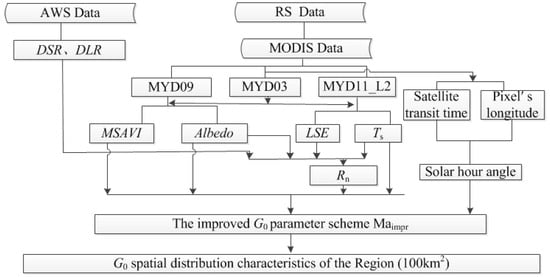
Figure 9.
The inversion process of ground surface soil heat flux G0 in the study area.
G0 in the study area was estimated by Equation (12). The solar time angle t was obtained from the satellite transmitting time and the longitude of the pixel in question [52]. The satellite-derived vegetation indices are obtained as described in Section 3.2. The land surface albedo α is obtained using an empirical formula and band 1~5 and band 7 data in the MODIS product MYD09 [54,55,56]:
where R1, R2, R3, R4, R5, and R7 are the reflectances of bands 1, 2, 3, 4, 5, and 7 of the MODIS data product MYD09. The residual standard error (RSE) of the empirical formula is not more than 0.02, as validated by Shunlin Liang et al. [54].
The net radiation Rn can be obtained through the surface radiation balance equation [57]:
where α is the land surface albedo (Equation (14)), σ is Stefan-Boltzmann constant (5.67 × 10−8 W m−2·K−4). DSR and DLR are the incoming short and long wave radiation fluxes, respectively (W/m2). DSR and DLR in the study area were only a little different, and they could be replaced by actual values of DSR and DLR at the TGL station measured when the satellite transited [58]. The land surface temperature Ts was directly obtained from the MODIS land surface temperature data product MOD11_L2. The land surface emissivity εs was estimated using the MYD11_L2 data product and a nonlinear formula [59]:
where ε31 and ε32 are the emissivity of band 31 and band 32 in MYD11_L2, respectively. The residual standard error (RSE) of the empirical formula was approximately 0.027, as validated by Shunlin Liang [59].
The following image (taken at Beijing time: 2014.07.24 14:40, Figure 10) was used as a case to discuss the performance of the improved scheme Maimpr in the study area.

Figure 10.
The spatial (a) and numerical (b) distribution of ground surface soil heat flux G0 in the study area.
In the study region depicted, G0 is low in the southeast and high in the northwest (Figure 10a), and was ranged between 140-180 W/m2, which accounted for 82% of the total data (Figure 10b).
The land surface emissivity LSE gap was small (Figure 11d) in the study area, and the net radiation Rn was mainly affected by the land surface temperature Ts and the land surface albedo α (Equation (15)). In addition, the solar time angle was not significantly different, therefore, the spatial distribution of the ground surface soil heat flux G0 was mainly determined by Ts, α, and MSAVI (Equation (12)).
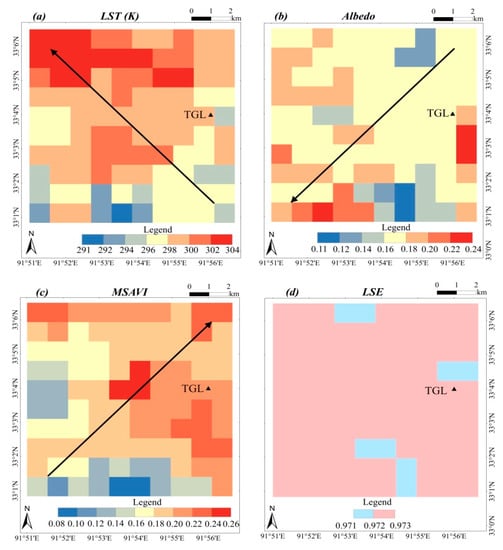
Figure 11.
The spatial distribution characteristics of the land surface temperature LST (a), land surface albedo Albedo (b), MSAVI (c), and land surface emissivity LSE (d) in the study area.
There was a significant positive correlation between the “observed” G0 and the measured Ts in the data measured at the TGL station (Figure 12a), while the “observed” G0 decreased with the increasing “measured” land surface albedo α (Figure 12b). This is consistent with previous findings [60,61]. The relationship between the spatial distribution patterns for Ts (Figure 11a) and G0 (Figure 10a) in the study area was also consistent with the above analysis. The values in the spatial distribution pattern were low in the southeast and high in the northwest. However, the spatial distributions of the surface albedo α (Figure 11b) and the surface soil heat flux G0 (Figure 10a) were negatively correlated. From south to north, α gradually decreases, while G0 gradually increases. These results demonstrate the reliability of the improved G0 Maimpr parameterization scheme based on remotely sensed data since they are in line with the actual situation in the study region.
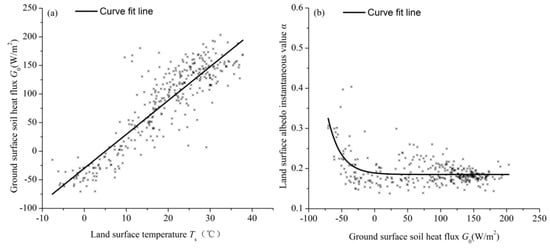
Figure 12.
The relationship between the “observed” G0 and the measured land surface temperature Ts (a) and the relationship between the “observed” G0 and the measured land surface albedo α (b) at the TGL station on sunny summer days of 2010–2012.
5.3. Comparison of the G0 Parameterization Schemes Maimpr and Ma
The two schemes Maimpr and Ma were tested against the validation data (Table A3 in Appendix B), and the performance of the two schemes was compared.
The correlation coefficient a between “observed” G0 (TDEC) data and G0 values simulated by the Ma scheme for each station using remotely measured data was less than 1, while the correlation coefficient a between “observed” G0 (TDEC) and G0 estimated by the Maimpr scheme for each station was greater than 1, indicating that the Ma model overestimated values in permafrost regions, while Maimpr slightly underestimated values (Figure 13). The coefficient of determination R2 for the Maimpr scheme was greater than the R2 of the Ma scheme, and the coefficient α of the Maimpr scheme was closer to 1. This is another demonstration that the improved Maimpr scheme performed better than the Ma scheme in the permafrost region.
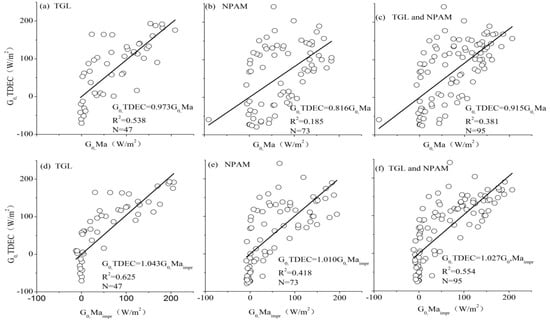
Figure 13.
Comparison between the Maimpr and Ma schemes at each site.
The same conclusion was reached from the remotely sensed data. Data measured at the TGL site in summer 2014 were also used because of the lack of remote sensing data in the study area, and the images produced at three moments (Beijing time: 2014.6.30 15:25, 2014.7.24 14:40, and 2014.9.18 15:25) were selected for study.
From Table 9, it can be concluded that the result of the Maimpr scheme were closer to the “measured” G0 (TDEC) data than the results of the Ma scheme, when using either directly measured data or AQUA/MODIS data.

Table 9.
Land surface parameters and ground surface soil heat flux G0 inverted in the images taken at three selected times (hh:mn dd. mm) in 2014.
The negative G0 are not well simulated by the schemes Maimpr and Ma, while the performance of the scheme Maimpr is obviously better than that of the scheme Ma in the respect (Figure 14, which is a line chart converted from the data of Figure 13). Therefore, from the effect of simulating negative G0, the scheme Maimpr is also better than the scheme Ma in permafrost regions on the QTP.
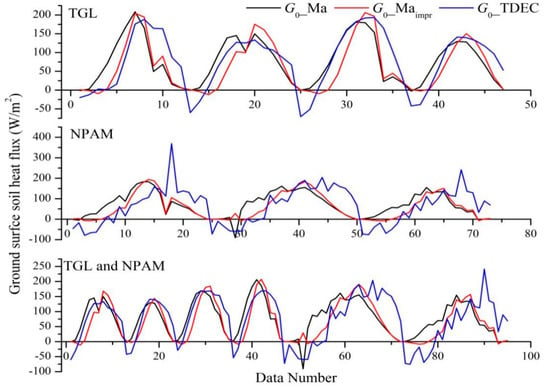
Figure 14.
Comparison between the Maimpr and Ma schemes at each site.
6. Conclusions
Four existing G0 parameterization schemes used on the QTP were evaluated against observation data. To introduce the phase difference between G0 and Rn, an improved G0 parameterization scheme Maimpr, which factors in the solar time angle, was established. Data from sites across a 100 km2 permafrost region were used to verify the reliability of the Maimpr scheme. The following conclusions were drawn:
The phase shifts between G0 and Rn in permafrost regions and seasonally frozen ground regions differ considerably. In permafrost regions, the shift is larger than it is in seasonally frozen ground regions. The improved G0 Maimpr parameterization scheme was established based on the Ma scheme, by representing the characteristic impact of phase shifts in permafrost regions of the QTP.
The Maimpr scheme produced satisfactory reliability. At both sites in the study area, the maximum values of RMSE and MAE for the Maimpr scheme were 6.102 W/m2 and 5.382 W/m2, respectively. The G0 obtained using MODIS data by the Maimpr scheme, satellite-derived land surface temperature Ts and the satellite-derived land surface albedo α in the study area were also consistent with the actual situation. The negative G0 are not well simulated by the scheme Maimpr, while the scheme Maimpr is obviously better than others in the respect.
A parameterization scheme fixed to the actual situation contributes to the related research into G0 in permafrost regions and leads to a deeper understanding these areas. The Maimpr scheme nevertheless needs further improvement because of the limited number of observation sites used in this study. A longer time series and multi-site observations would improve the understanding of energy balance processes, especially in the permafrost regions.
Author Contributions
Conceptualization and methodology, T.W., J.W., J.Y. and C.Y.; Formal analysis, C.Y.; Software, X.Z., J.N. and J.H.; Validation, T.W., J.W., J.Y. and C.Y.; Investigation, L.Z., R.L., and C.X.; Writing—original draft preparation, C.Y.; Writing—review and editing, T.W. and C.Y.; Funding acquisition, T.W.
Acknowledgments
This study was funded by the Strategic Priority Research Program of Chinese Academy of Sciences (Grant No. XDA2003020102) and National Natural Science Foundation of China (41721091; 41690142; 41771076; 41571069; 41575012). The observation data are provided by Cryosphere Research Station on the Qinghai-Tibet Plateau and Cold and Arid Regions Sciences Data Center at Lanzhou (http://westdc.westgis.ac.cn). The remote sensing data are provided by the National Oceanic and Atmopspheric Administration (NOAA/AVHRR-14, http://www.nsof.class.noaa.gov/saa/products/search?sub_id=0&datatype_family=AVHRR&submit.x=21&submit.y=3) and National Aeronautics and Space Administration (MODIS Data, https://ladsweb.modaps.eosdis.nasa.gov/search/). ASTER Global Digital Elevation Model is provided by the National Aeronautics and Space Administration (http://gdem.ersdac.jspacesystems.or.jp/download.jsp).
Conflicts of Interest
The authors declare no conflict of interest.
Appendix A. (The Ratio Γ of G0 to Rn)
The adjustment processes of the four models (SEBAL, Ma, Moran and SEBS) in the northern Tibetan plateau are listed as follows in detail using Fitting data in Table A1 of Appendix B:
(1) SEBALadj/Maadj
The coefficients of G0 parameterization scheme in SEBAL shall be re-determined based on the measured data of observation stations in the research area and the unified form can be written as follows:
In Equation (A1), Ts, α, α and NDVI are all known, so Equation (A1) can be modified to:
At this time, Equation (A1) becomes a multivariate linear Equation (A2) that is convenient to calculate.
The concrete form of the scheme SEBALadj is obtained by the in-suit data through SPSS statistical software:
Similarly, the specific form of the scheme Maadj is determined:
(2) Moranadj
The G0 parameterization scheme Moran have been introduced earlier (Section 3.2), it shows that the ratio of G0 to Rn is only related to NDVI and NDVI is almost unchanged every day, so G0/Rn can be considered a constant value within one day that is to say, there is a linear relationship with intercept 0 between G0 to Rn every day, as follows:
In Equation (A5), Γ(i) represents the slop of the regression of the linear relationship between “observed” G0 to measured Rn on the i day. Then, the NDVI(i) retrieved from remote sensing data (MOD09) is substituted into the Equation (A5).
Combine Equation (A5) and Equation (A6), get:
Substituting the corresponding Γ(i) and NDVI(i) into Equation (A7) can solve the unknown coefficients a and b. The scheme Moranadj fitting diagram is as follows:
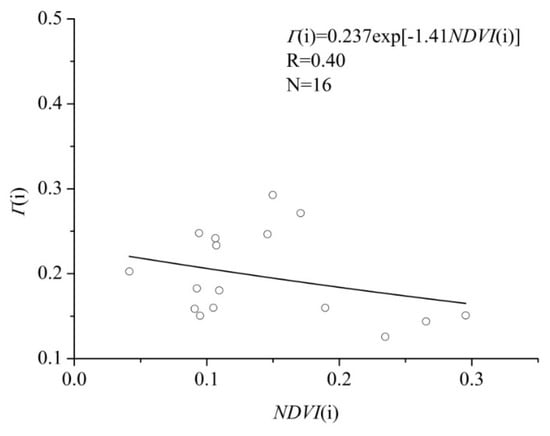
Figure A1.
The fitting curve between the coefficient Γ(i) of the linear relationship between G0 to Rn and the corresponding NDVI(i).
From Figure A1, a and b in Equation (A7) are 0.237 and −1.41 respectively, i.e., Moranadj has the following specific forms:
(3) SEBSadj
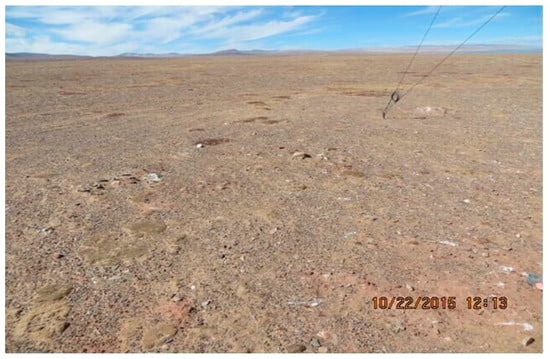
Figure A2.
Picture of ZNH underlying surface (taken by Hu guojie).
The ratio Γs of G0 to Rn in SEBS is 0.315 in bare soil [33]. Because the underlying surface of ZNH is bare soil (Figure A2) and the vegetation of AYK is very sparse, the two sites are treated as bare soil. In the study, Γs on the northern Qinghai-Tibetan Plateau can be obtained by linear fitting of the data from these two stations and takes the value of 0.25 (Figure A3). In addition, the scheme Moranadj can also prove this point. In the case of bare soil, the NDVI value is 0 and it is substituted into Moranadj (Equation (A8)) to obtain The ratio Γs of G0 to Rn (0.237), which is quite different from 0.315, but close to 0.25. It can be seen that Γs in the scheme SEBS (0.315) is overestimated on the plateau. Replace 0.315 with 0.25 to get SEBSadj:

Figure A3.
The ratio of G0/Rn in bare soil estimated by the in-suit data from AYK and ZNH.
Appendix B. (Charts)

Table A1.
Experimental data measured at XDT, TGL, AYK, and ZNH in 2014.
Table A1.
Experimental data measured at XDT, TGL, AYK, and ZNH in 2014.
| AWS | Dates of the Selected Clear-Sky Days (dd.mm) | Dates of the Selected Fitting Data (dd.mm) | Dates of the Selected Validation Data (dd.mm) |
|---|---|---|---|
| XDT | 03.06, 03.07, 11.07, 12.07, 14.07, 22.07, 23.07 | 03.06, 03.07, 12.07, 14.07, 23.07 | 11.07, 22.07 |
| TGL | 03.07, 23.07, 24.07, 13.08 | 03.07, 23.07, 13.08 | 24.07 |
| AYK | 30.06, 02.07, 09.07, 22.08, 23.08, 24.08 | 30.06, 09.07, 22.08, 24.08 | 02.07, 23.08 |
| ZNH | 30.06, 02.07, 12.07, 13.07 | 30.06, 12.0, 13.07 | 02.07, |

Table A2.
Dates of the selected clear-sky days at TGL (20.05–20.09, 2010–2012).
Table A2.
Dates of the selected clear-sky days at TGL (20.05–20.09, 2010–2012).
| AWS | Year | Dates of the Selected Clear-Sky Days (month/day) |
|---|---|---|
| TGL | 2010 2011 2012 | 20.05, 22.05, 27.05, 09.06, 10.06, 11.06, 09.07, 19.07, 29.07, 31.07, 30.08, 06.09, 10.09 22.06, 27.06, 01.07, 15.07, 23.07, 08.08, 22.08, 26.08, 28.08 22.05, 23.05, 27.05, 12.07, 12.08, 25.08, 04.09 |

Table A3.
The measured data used to fit and verify the parameterized scheme under clear-sky conditions at each site in the permafrost region.
Table A3.
The measured data used to fit and verify the parameterized scheme under clear-sky conditions at each site in the permafrost region.
| AWS | Year | Dates of the Selected Fitting Data | Dates of the Selected Validation Data | |
|---|---|---|---|---|
| TGL | 2010 2011 2012 | 20.05, 27.05, 09.06, 11.06, 09.07, 29.07, 31.07, 30.08, 10.09 22.06, 01.07, 15.07, 23.07, 22.08, 28.08 22.05, 27.05, 12.07, 25.08, 04.09 | 22.05, 10.06, 19.07, 06.09 27.06, 08.08, 26.08 23.05, 12.08 | |
| NPAM | 1998 | 11.07, 16.07, 27.07, 09.08, 15.08, 17.08, 21.08 | 12.07, 06.08, 16.08 | |
| Total | TGL(77) | 2010 2011 2012 | 20.05, 09.06, 11.06, 29.07, 10.09 15.07 04.09 | 10.06, 06.09 27.06 25.08 |
| NPAM(76) | 1998 | 11.07, 16.07, 09.08 | 12.07, 06.08 | |
* TGL(77) represents the 77 samples of data from the TGL site included in the overall dataset when TGL and NPAM are taken as a whole.
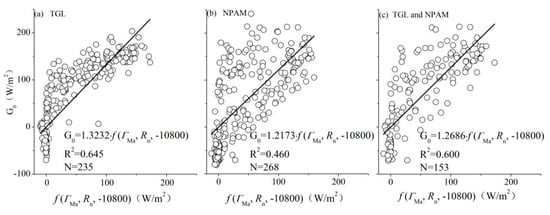
Figure A4.
The coefficient a of each site when the phase shift c is equal to -10800 s (in order to ensure that the result will not be biased towards a certain site), N on graph (c) represents a portion of the sample data, including the same amount of data from TGL and NPAM (Table A3), not a simple combination of all of the data from the two sites).
References
- Bian, L.; Lu, L.; Lu, C.; Chen, Y.; Gao, Z. The characteristics of radiation balance components of the Tibetan Plateau in the summer of 1998. Chin. J. Atmos. Sci. 2001, 25, 577–588. [Google Scholar]
- Cheng, G.D.; Zhao, L. The problems associated with permafrost in the development of the Qinghai-Xizang Plateau. Quat. Sci. 2000, 20, 521–553. [Google Scholar]
- Wang, L.; Zhou, J.; Qi, J.; Sun, L.; Yang, K.; Tian, L.; Lin, Y.; Liu, W.; Shrestha, M.; Xue, Y.; et al. Development of a land surface model with coupled snow and frozen soil physics. Water Resour. Res. 2017, 53, 5085–5103. [Google Scholar] [CrossRef]
- Feng, L. Estimation of Radiation Balance Components and Soil Heat Flux over the Northern Tibetan Plateau Based on Satellite Remote Sensing; University of Science and Technology of China: Hefei, China, 2016. [Google Scholar]
- Wang, S. Study of permafrost degradation in the Qinghai-Xizang Plateau. Adv. Earth Sci. 1997, 12, 164–167. [Google Scholar]
- Jin, H.; Li, S.; Wang, S.; Zhao, L. Impacts of climatic change on permafrost and cold regions environments in China. Acta Geogr. Sin. 2000, 55, 161–173. [Google Scholar]
- Ding, Y. Recent degradation of permafrost in China and the response to climatic warming. In Proceedings of the 7th International Conference of Permafrost, Yellowknife, NT, Canada, 23–27 June1998; pp. 225–230. [Google Scholar]
- Li, S.; Nan, Z.; Zhao, L. Impact of Soil Freezing and Thawing Process on Thermal Exchange between Atmosphere and Ground Surface. J. Glaciol. Geocryol. 2002, 24, 506–511. [Google Scholar]
- Riseborough, W.D. Soil latent heat as a filter of the climate signal in permafrost. In Proceedings of the Fifth Canadian Permafrost Conference, Collection Nordicana No 54 Universite’ Laval, Yellowknife, NT, Canada, 6 June 1990; pp. 199–205. [Google Scholar]
- Boike, J.; Juszak, I.; Lange, S.; Chadburn, S.; Burke, E.; Overduin, P.P.; Roth, K.; Ippisch, O.; Bornemann, N.; Stern, L.; et al. A 20-year record (1998–2017) of permafrost, active layer and meteorological conditions at a high Arctic permafrost research site (Bayelva, Spitsbergen). Earth Syst. Sci. Data 2018, 10, 355–390. [Google Scholar] [CrossRef]
- Moritz, L.; Sebastian, W.; Max, H.; Wolfgang, D.; Julia, B. Satellite-based modeling of permafrost temperatures in a tundra lowland landscape. Remote Sens. Environ. 2013, 135, 12–24. [Google Scholar] [CrossRef]
- Zhang, L.; Jiang, H.; Li, L. Study of Calculation of Soil Heat Conduction: Progress and Prospect. J. Glaciol. Geocryol. 2004, 26, 569–575. [Google Scholar]
- Xu, Z.; Liu, S.; Xu, T.; Chuang, D. The observation and calculation method of soil heat flux and its impact on the energy balance closure. Adv. Earth Sci. 2013, 28, 875–889. [Google Scholar]
- Liebethal, C.; Huwe, B.; Foken, T. Sensitivity analysis for two ground heat flux calculation approaches. Agric. For. Meteorol. 2005, 132, 253–262. [Google Scholar] [CrossRef]
- Tanaka, K.; Ishikawa, H.; Hayashi, T.; Tamagawa, I.; Ma, Y. Surface energy budget at Amdo on the Tibetan plateau using GAME/Tibet IOP98 data. J. Meteorol. Soc. Jpn. 2001, 79, 505–517. [Google Scholar] [CrossRef]
- Ogée, J.; Lamaud, E.; Brunet, Y.; Berbigier, P.; Bonnefond, J.M. A long-term study of soil heat flux under a forest canopy. Agric. For. Meteorol. 2001, 106, 173–186. [Google Scholar] [CrossRef]
- Mayocchi, C.L.; Bristow, K.L. Soil surface heat flux: Some general questions and comments on measurements. Agric. For. Meteorol. 1995, 75, 43–50. [Google Scholar] [CrossRef]
- Choudhury, B.J.; Idso, S.B.; Reginato, R.J. Analysis of an empirical model for soil heat flux under a growing wheat crop for estimating evaporation by an infrared-temperature based energy balance equation. Agric. For. Meteorol. 1987, 39, 283–297. [Google Scholar] [CrossRef]
- Yu, G.-R.; Wen, X.-F.; Sun, X.-M.; Tanner Bertrand, D.; Lee, X.; Chen, J.-Y. Overview of ChinaFLUX and evaluation of its eddy covariance measurement. Agric. For. Meteorol. 2006, 137, 125–137. [Google Scholar] [CrossRef]
- Van Wijk, W.R.; De Vries, D.A. Periodic temperature variations in a homogeneous soil. In Physics of Plant Environment; Van Wijk, W.R., Ed.; North-Holland Publ. Co.: Amsterdam, The Netherlands, 1963; pp. 102–143. [Google Scholar]
- de Bruin, H.A.R.; Holtslag, A.A.M. A Simple Parameterization of the Surface Fluxes of Sensible and Latent Heat During Daytime Compared with the Penman-Monteith Concept. J. Appl. Meteorol. 1982, 21, 1610–1621. [Google Scholar] [CrossRef]
- Yang, K.; Wang, J. A temperature prediction and correction method for calculating surface soil heat flux based on soil temperature and humidity data. Sci. China Ser. D-Earth Sci. 2008, 38, 243–250. (In Chinese) [Google Scholar]
- Bastiaanssen, W.G.M. Regionalization of surface fluxes and moisture indicators in composite terrain. Ph.D. Thesis, Wageningen Agricultural University, Wageningen, The Netherlands, 1995. [Google Scholar]
- Wang, J.; Ma, Y.; Menneti, M.; Bastiaanssen, W. The scaling-up of processes in the heterogeneous landscape of HEIFE with the aid of satellite remote sensing. J. Meteorol. Soc. Jpn. 1995, 73, 1235–1244. [Google Scholar] [CrossRef]
- Ma, Y.; Wang, J.; Menenti, M.; Bastiaanssen, W. Estimation of fluxes over the heterogeneous land surface with the aid of satellite remote sensing and ground observation. ACTA Meteorol. Sin. 1999, 57, 180–189. [Google Scholar]
- Ma, Y.; Ishikawa, H.; Tsukamoto, O.; Ishikawa, H.; Su, Z.; Menenti, M.; Wang, W.; Wen, W. Determination of Regional land surface heat flux densities over heterogeneous landscape of HEIFE Integrating satellite remote sensing with field observations. J. Meteorol. Soc. Jpn. 2002, 80, 485–501. [Google Scholar] [CrossRef]
- Fuchs, M.; Hadas, A. The heat flux in a nohomogeneous bare loessial soil. Bound Layer Meteorol. 1972, 3, 191–200. [Google Scholar] [CrossRef]
- Pirrier, A. Assimilation nette, utilization de l’eau et micriclimat d’un champ de mais. Annu. Agronomy 1975, 26, 139–157. [Google Scholar]
- Idso, S.B.; Aase, J.K.; Jackson, R.D. Net radiation-soil heat flux relations as influenced by soil water content variations. Bound. Layer Meteorol. 1975, 9, 113–122. [Google Scholar] [CrossRef]
- Montheith, J.L. Principles of Environmental Physics; Edward Aarnold: London, UK, 1973. [Google Scholar]
- Reginato, R.J.; Jackson, R.D.; Pinter, P.J. Evapotranspiration calculated from remote multispeetral and ground station meteorological data. Remote Sens. Environ. 1985, 18, 75–89. [Google Scholar] [CrossRef]
- Jackson, R.D.; Moran, M.S.; Gay, L.W.; Raymond, L.H. Evaluating evaporation from field crops using airborne radiometry and ground-based meteorological data. Irrig. Sci. 1987, 8, 81–90. [Google Scholar] [CrossRef]
- Su, Z. The surface energy balance system (SEBS) for estimation of turbulennt heat fluexes. Hydrol. Earth Syst. Sci. 2002, 6, 85–99. [Google Scholar] [CrossRef]
- Huete, A.R.; Jackson, R.D.; Post, D.F. Spectral response of a plant canopy with different soil back grounds. Remote Sens. Environ. 1985, 17, 37–53. [Google Scholar] [CrossRef]
- Alfredo, H.; Soil, R. Sun angle interactions on partial canopy spectra. Int. J. Remote Sens. 1987, 8, 1307–1317. [Google Scholar] [CrossRef]
- Sellers, P.J. Canopy reflectance, photosynthesis and transpiration. Int. J. Remote Sens. 1985, 6, 1335–1372. [Google Scholar] [CrossRef]
- Menenti, M.; Bastiaanssen, W.G.M.; Hefny, K.; Abd EI Karim, M.H. Mapping of Ground Water Losses by Evaporation in the WESTERN Desert of Egypt; Report No.43; DLO Winand Staring Center: Wageningen, The Netherlands, 1991; p. 116. [Google Scholar]
- Ma, Y.; Ishikawa, H.; Tsukamoto, O.; Menenti, M.; Su, Z.; Yao, T.; Koike, T.; Yasunari, T. Regionalization of surface fluxes over heterogeneous landscape of the Tibetan Plateau by using satellite remote sensing. J. Meteorol. Soc. Jpn. 2003, 81, 277–293. [Google Scholar] [CrossRef]
- Ma, Y.; Wang, J.; Huang, R.; Wei, G.; Menenti, M.; Su, Z.; Hu, Z.; Gao, F.; Wen, J. Remote sensing parameterization of land surface heat fluxes over arid area andsemi-arid areas. Adv. Atmos. Sci. 2003, 20, 530–539. [Google Scholar] [CrossRef]
- Santanello, J.; Friedl, M. Diurnal covariation in soil heat flux and net radiation. J. Appl. Meteorol. 2003, 42, 851–862. [Google Scholar] [CrossRef]
- Paul, C.; Kustas, D.; William, P.; Anderson Martha, C.; Agam, N.; Tolk, J.A.; Evett, S.R.; Howell, T.A.; Gowda, P.H.; O’Shaughnessy, S.A. Two-source energy balance model estimates of evapotranspiration using component and composite surface temperatures. Adv. Water Resour. 2012, 50, 134–151. [Google Scholar] [CrossRef]
- Li, S.; Cheng, G. Map of the Frozen Ground in China; Gansu Culture Press: Lanzhou, Chnia, 1996. [Google Scholar]
- Ma, W.; Ma, Y.; Hu, Z.; Li, M.; Sun, F.; Gu, L.; Wang, J.; Qian, Z. The contrast between the radiation budget plus seasonal variation and remote sensing over the northern Tibetan Plateau. J. Arid Land Resour. Environ. 2005, 19, 109–115. [Google Scholar]
- Xiao, Y.; Zhao, L.; Li, R.; Yao, J. Seasonal variation characteristics of surface energy budget components in permafrost regions of northern Tibetan Plateau. J. Glaciol. Geocryol. 2011, 33, 1033–1039. [Google Scholar]
- Zuo, J.; Wang, J.; Huang, J.; Li, W.; Wang, G.; Ren, H. Estimation of ground heat flux for a Semi-Arid grassland and its impact on the surface energy budget. Plateau Meteorol. 2010, 29, 840–848. [Google Scholar]
- Moran, M.S.; Jackson, R.D.; Raymond, L.H.; Gay, L.W.; Slater, P.N. Mapping surface energy balance components by combining Landsat thermatic mapper and ground-based meteorological data. Remote Sens. Environ. 1989, 30, 77–87. [Google Scholar] [CrossRef]
- Yu, W.; Ma, M.; Wang, X.; Geng, L.; Tan, J.; Shi, J. Evaluation of MODIS LST Products Using Longwave Radiation Ground Measurements in the Northern Arid Region of China. Remote Sens. 2014, 6, 11494–11517. [Google Scholar] [CrossRef]
- Deering, D.W. Rangeland reflectance characteristics measured by aircraft and spacecraft sensors. Ph.D. Thesis, Texas A&M Universtiy, College Station, TX, USA, 1978. [Google Scholar]
- Qi, J.; Chehbouni, A.; Huete, A.R.; Kerr, Y.H.; Sorooshian, S. A Modified Soil Adjusted Vegetation Index. Remote Sens. Environ. 1994, 48, 119–126. [Google Scholar] [CrossRef]
- Xu, J. Analysis of land surface temperature in Mt. Lu region through RS retrieval. Geomat. Spat. Inf. Technol. 2016, 39, 122–124. [Google Scholar]
- Min, W. Analysis of adapatabilities of remote sensing models for heat flux over hilly land. Sci. Meteorol. Sin. 2009, 29, 386–389. [Google Scholar]
- Wang, B. Solar Radiation Calculation Lecture, Lecture 1 Calculation of Solar Astronomical Parameters. Sol. Energy 1999, 2, 8–10. [Google Scholar]
- Wan, Z.; Li, Z. A physics-based algorithm for retrieving land-surface emissivity and temperature from EOS/MODIS data. IEEE Trans. Geosci. Remote Sens. 1997, 35, 980–996. [Google Scholar] [CrossRef]
- Liang, S.; Chad, J.; Andrew, S.; Russ, L.; Fang, H.; Chen, M.; Walthall, C.L.; Daughtry, C.E.T.; Hunt, R., Jr. Narrowband to broadband conversions of land surface albedo:II. Validation. Remote Sens. Environ. 2002, 84, 25–41. [Google Scholar] [CrossRef]
- Zhang, L.; Yu, G.; Gu, F.; He, H.; Zhang, L.; Han, S. Uncertainty analysis of modeled carbon fluxes for a broad-leaved Korean pine mixed forest using a process-based ecosystem model. J. For. Res. 2017, 17, 268–282. [Google Scholar] [CrossRef]
- Liang, S. Narrowband to broadband conversions of land surface albedo:I Algorithms. Remote Sens. Environ. 2000, 76, 213–238. [Google Scholar] [CrossRef]
- Amatya, P.M.; Ma, Y.; Han, C.; Wang, B.; Devkota, L.P. Recent trends(2003–2013) of land surface heat fluxes on the southern side of the central Himalayas, Nepal. J. Geophys. Res. Atmos. 2015, 120, 11957–11970. [Google Scholar] [CrossRef]
- Liu, Y.; Goto, S.; Zhuang, D.; Kuang, W. Urban Surface Heat Flux Inversion Based on Infrared Remote Sensing and the Relationship with Land Cover. Acta Geogr. Sin. 2012, 67, 101–112. [Google Scholar]
- Liang, S. Quantitative Remote Sensing of Land Surface; Science Press: Beijing, China, 2015; p. 283. [Google Scholar]
- Liu, H.; Yang, X.; Zhang, Q.; Wang, R.; Wang, S.; Wang, H.; Zhang, K. Contrast of Ground Surface Radiation-Energy Balance in Summer and Winter on Dunhuang Gobi. J. Desert Res. 2009, 29, 558–565. [Google Scholar]
- Ye, J.; Liao, Q.; Li, Z.; Li, W. Comparison of adaptability of remote sensing models for soil heat flux estimation over semiarid area. Remote Sens. Inf. 2012, 27, 79–85. [Google Scholar]
© 2019 by the authors. Licensee MDPI, Basel, Switzerland. This article is an open access article distributed under the terms and conditions of the Creative Commons Attribution (CC BY) license (http://creativecommons.org/licenses/by/4.0/).